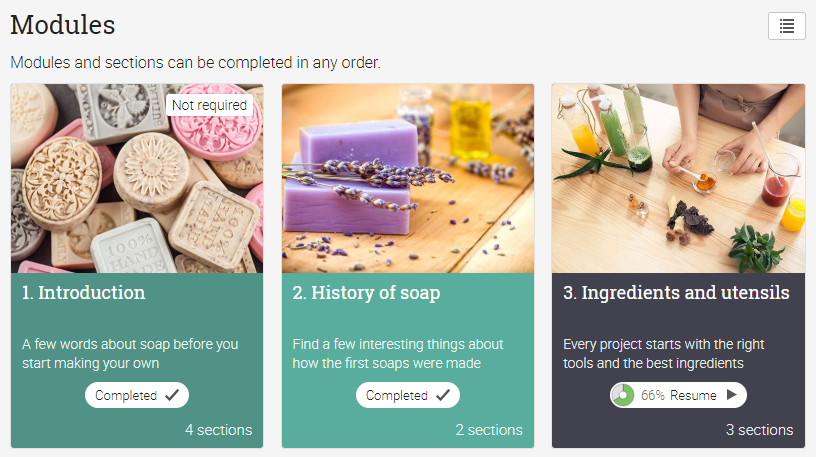This post has been updated on April 9, 2020.
When people first enroll in your online course the enthusiasm is at an all-time high. Finally, the thing you’ve worked so hard for starts to pay off. However, once the course progresses you’ll notice learners dropping out, sometimes after completing half of it, one module or not even starting one section!
In fact, completion rates for online courses are on average as low as 5-15%. So what is that about? Should we just give up? The answer is a resounding: no! Online entrepreneurs need to find the right spot between two contrasting tendencies: the learner’s desire to change versus instant gratification.
They do start off with the intention to change something and that’s why your course should focus on guiding them from point A to point B. At the same time, people have a tendency to resist that change.
You should know that there are many reasons why learners abandon online courses, both personal and related to the said courses:
- Learners are busy
- They don’t understand the instructions
- The course seems long and difficult
- The course seems too easy
- Learners simply forget
- Their learning needs are not met
- You didn’t do any sort of follow-up
- They got what they needed with a few modules
Even if 100% course completion isn’t your ultimate goal, how do you get from 5% to 50% or 70%? In other words, how do you keep them motivated and engaged?
What you can do about low online course completion rates
I think it’s clear by now that there are things that you can do and there are things that you can’t. You can’t clear up their busy schedules, but you can definitely do something to motivate learners and build an overall informative as well as a transformative online course.
Start with the middle
Learner engagement needs to be embedded in the design of your course. Once you’ve created the course plan or curriculum, you might be tempted to work in order, from introduction to conclusion.
However, experienced instructors do it a little differently: they start creating the middle and then work their way to the introduction. Once you’ve figured out the “meaty part” of the course e.g the middle and end, certain things happen. You get a better sense of how to create assessments, the optimal video length, the best way to express your ideas; in other words, you have what you need to create a better, more engaging first module/modules.
A stellar introduction combined with their initial enthusiasm means that they will be less likely to drop out early.
Offer community support
Building an online community is a fantastic way to create more value for learners. They don’t just get an online course — they will learn together and befriend people with the same interests. Of course, there’s also the power of peer pressure and seeing that the course actually helps others as well.
For this, it’s up to you to get things going. Start a forum asking people to introduce themselves, create groups centered on different interests, let them know that they can also start discussions.
Read more: 9 Tips on how to build a learning community using LMS tools
And since you’re the instructor, try to schedule a Q&A whenever possible, make yourself available for help or questions. Plus, if people start dropping out seemingly for no reason, you can always send them custom notifications or emails to get them back on track. Don’t be shy to ask them why they’ve been inactive.
Show their progress
You know what makes me happy? The progress bar. That’s right, that check sign right there:

So I’ve heard it’s not just me. In fact, people like checking their progress and seeing how much they have to do from point A to B. In fact, you should make it easy for learners to know that by estimating the time it takes to complete each module. You can also make lessons a bit shorter and easy to digest. It’s really off-putting when they see a 2-hour video to complete in one take so break it in multiple videos.
Read more: 4 Ways to create meaningful microlearning in your online course
There’s also this nice trick to nudge them to actually apply what they’re learning, through a quiz or even a real-life project. By seeing their progress they’ll just be reassured that their time is not wasted and they can actually do this.
Get your best game on
We all like to play games sometimes. Gamification’s meteoric rise in popularity certainly tells us so. Your learners could use a little motivation with badges or points that they receive for completing modules. Add in a leaderboard if you want to!
So remember that in order to complete the course they need a little encouragement and extrinsic motivation. Once they complete a lesson, they get this sense of accomplishment that makes them want to go back and learn more.
Plus, you can do whatever you want with your game, including offering a prize at the end such as a certificate of completion or a discount.
Read more: How to include gamification in your course design
Set some deadlines
Sure, the whole point of an online course that learners take voluntarily is to complete it at their own pace. The problem with that is that they will procrastinate if it’s not a priority for them.
So you can make use of drip content, which is just a term for locking and unlocking modules based on their completion. Let’s say that they’ve started the course and can only see module 1. To unlock the rest of it, they have to complete the first module. You can also schedule them to appear once a week only or set deadlines for certain elements such as quizzes.
Make them see the value of your course
So there are many reasons why we put so much value on education. For adults especially, non-mandatory education is also very pricey and I’m not just talking about university degrees either.
The training market is huge and diverse. You’d probably think that putting a lower price will attract more buyers. Sure, they might buy it right away and forget about it the next day. Once you put a higher price tag things change. They’ll want to get something out of that investment because here is the thing: an online course should be an investment, not a mindless shopping experience. Pricing it too low will get people a sense of “it’s fine I didn’t spend all of that money”.
So, figure out how much your prospective clients might earn on average (use the buyer persona) and adjust your pricing accordingly. A $100 dollar course might mean a lot for someone who earns $2,000/month versus someone who makes $4,000.
Read more: How to budget for your online course business
Optimize on the go learning
Learners want more choices when it comes to accessing their courses. Optimizing courses for mobile learning is a given. You need to make sure that everything looks great on mobile devices, whether they access courses via an app or a browser.
For this, you can use a learning platform that already offers an app, or test your website on various devices to see whether it works OK. In any case, encouraging learners to install an app to take your courses or simply reminding them at the beginning that they can learn on the go can make a big difference. Now at least they don’t have as many excuses not to log in!
Final thoughts
Remember that learners have to constantly juggle between learning and putting things off until “tomorrow”. While we’re all guilty of abandoning online courses, and an overall 100% completion rate is not a realistic goal, you can take some steps before, during, and after learners enroll in your course to make sure that they’re as engaged as possible. As a result, you’ll see learners returning for more, recommending your courses, being generally happy with their purchase.







